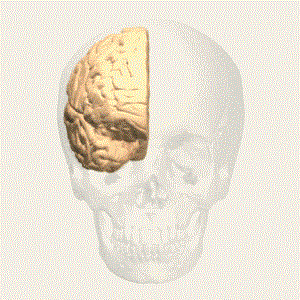Left-sided hemiparesis
(Stroke on the right side of the brain)
After a stroke in the right hemisphere the patient is paralyzed on the left side of the body and vice versa. Paralysis is not always the case.
In people who are right-handed, the speech and language center is located in the left hemisphere.
Hemiparesis and hemiplegia
Hemiparesis refers to one-sided ('hemi') weakness ('paresis') The words 'hemiparesis' and 'hemiplegia' are used next to each other in practice.
In fact, 'plegia' means complete paralysis and 'paresis' means partial paralysis;
On one side of the body both arm and leg and face can be affected. It may also be that only the arm is affected, or only the leg or facial muscles. Hemiparesis affects roughly 80 percent of stroke survivors, causing weakness or the inability to move one side of the body.
Symptoms after a stroke in the right
hemisphere
Remember: One person with a stroke in this hemisphere may have one or two of these symptoms, the other has multiple. Roughly speaking:
- movement disorders
- numbness or paralysis on the left side of the body
- impaired vision on the left side of both eyes. As if both glasses on the left side have been taped off (hemianopia)
- not realizing that the left side of the body or space exists (neglect)
no attention to the cripple side of the body
- the sense of space and time can be bad giving someone depth, shape, color and size can not assess and lost. Spatial awareness problems
- visuospatial problems
- often someone has little insight into his own behavior, problems and limitations (anosognosia)
- less understanding of (he or she does not 'understand') social situations
- language is often taken literally and jokes and underlying messages are not easily understood
- difficulty understanding humor
- difficult to estimate what the other emotion in the voice explains as anger, relief, sadness, joy (prosody)
- recognizing faces can be bad (prosopagnosia)
- difficulty in seeing the whole
- do not know how one should dress in what order (apraxia)
- fast, impulsive behavior, and sometimes inappropriate behavior
- sometimes little consideration for others
- overestimating him / herself
- reduced self-control
- easily aroused
- reduced disease understanding
The lobes
Scientists are still discovering more functions that were previously roughly attributed to the 'other' brain hemisphere. The brain works as a whole. The hemispheres are divided into lobes again.
Learn more about particular damage in these areas:
The blue area is the Frontal lobe
The yellow area is the Parietal lobe
The green area is the Temporal lobe
The red area is the Occipital lobe
